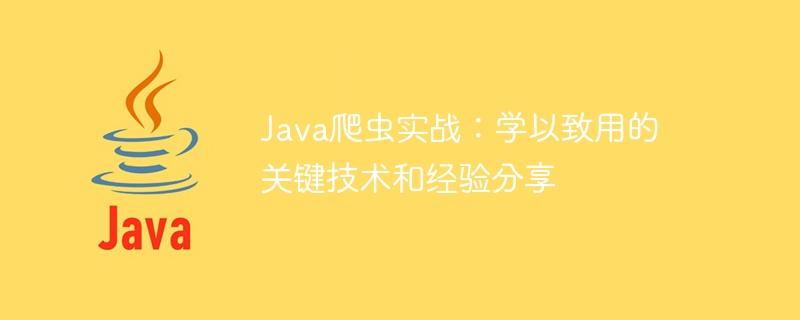Home >Java >javaTutorial >In-depth practice: Sharing of key Java crawler technologies and experiences that can be put into practice
In-depth practice: Sharing of key Java crawler technologies and experiences that can be put into practice
- WBOYWBOYWBOYWBOYWBOYWBOYWBOYWBOYWBOYWBOYWBOYWBOYWBOriginal
- 2023-12-26 15:27:381231browse

Java crawler practice: sharing of key technologies and experiences for applying what you have learned
Introduction: With the rapid development of the Internet, crawler technology has become the key to information acquisition and data analysis. Important tool. This article will introduce the key technologies and experience sharing of Java crawlers, and provide specific code examples to help readers better master and apply crawler technology.
1. Basic concepts and principles of crawlers
A crawler is a program that can automatically obtain network data and analyze it. It simulates human browsing behavior, accesses web pages and parses the data in them. . The basic principle is to send an HTTP request, obtain the HTML data returned by the server, and then use a parser to extract the required information.
2. Sharing of key technologies and experiences of crawlers
- HTTP request and response
The crawler first needs to send an HTTP request to obtain the HTML data of the web page. Using Java, you can send GET or POST requests through tool classes such as HttpURLConnection or HttpClient, and obtain the response data returned by the server. The following is an example of using HttpURLConnection to send a GET request:
import java.io.BufferedReader;
import java.io.IOException;
import java.io.InputStreamReader;
import java.net.HttpURLConnection;
import java.net.URL;
public class Spider {
public static void main(String[] args) throws IOException {
String url = "https://www.example.com";
HttpURLConnection connection = (HttpURLConnection) new URL(url).openConnection();
connection.setRequestMethod("GET");
connection.setConnectTimeout(5000);
connection.setReadTimeout(5000);
BufferedReader reader = new BufferedReader(new InputStreamReader(connection.getInputStream()));
String line;
StringBuilder response = new StringBuilder();
while ((line = reader.readLine()) != null) {
response.append(line);
}
reader.close();
connection.disconnect();
System.out.println(response.toString());
}
}- HTML parser
The HTML parser is used to parse the HTML data of the web page and extract the required information. Commonly used HTML parsing libraries in Java include jsoup, HtmlUnit, etc. The following is an example of using jsoup to parse HTML data:
import org.jsoup.Jsoup;
import org.jsoup.nodes.Document;
import org.jsoup.nodes.Element;
import org.jsoup.select.Elements;
public class Spider {
public static void main(String[] args) throws IOException {
String url = "https://www.example.com";
Document document = Jsoup.connect(url).get();
Elements elements = document.select(".class-name");
for (Element element : elements) {
String content = element.text();
System.out.println(content);
}
}
}- Data Storage
The data obtained by the crawler usually needs to be stored and analyzed. In Java, data can be stored using databases (such as MySQL, MongoDB, etc.), files (such as Excel, CSV, etc.) or memory (such as List, Map, etc.). The following is an example of storing data into a MySQL database:
import java.sql.Connection;
import java.sql.DriverManager;
import java.sql.PreparedStatement;
import java.sql.SQLException;
public class Spider {
public static void main(String[] args) throws SQLException {
Connection connection = DriverManager.getConnection("jdbc:mysql://localhost:3306/database", "username", "password");
PreparedStatement statement = connection.prepareStatement("INSERT INTO table_name (column1, column2) VALUES (?, ?)");
// 假设从网页中获取到的数据存储在dataList中
for (Data data : dataList) {
statement.setString(1, data.getField1());
statement.setString(2, data.getField2());
statement.executeUpdate();
}
statement.close();
connection.close();
}
}3. Summary
By learning and applying crawler technology, we can easily obtain various data on the Internet and conduct further analysis and application. This article introduces the key technologies and experience sharing of Java crawlers, including knowledge of HTTP requests and responses, HTML parsers, and data storage. I hope that by reading this article, readers can better master and apply crawler technology to realize their own needs.
The above is the detailed content of In-depth practice: Sharing of key Java crawler technologies and experiences that can be put into practice. For more information, please follow other related articles on the PHP Chinese website!

